September 1- 7, 2013: Issue 126
112th Australian Flag Day – September 3rd, 2013
Flags, standards and pennants began many centuries ago. Have you ever seen a picture of a knight who comes ‘with flags, standards and pennants flying’ or heard of the verse from the Song of Solomon in the Bible, written, according to some, circa 900 B.C.;
He brought me to the Bais HaYayin (banquet hall), and his degel (standard, pennant, banner, flag) over me is ahavah (love).
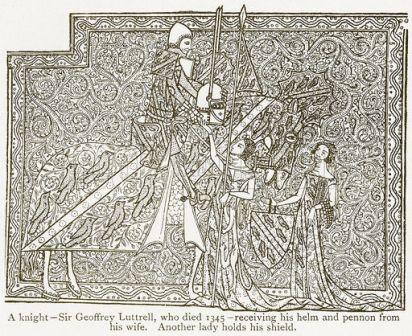 A pennon was one of the principal three varieties of flags carried during the Middle Ages (the other two were the banner and the standard). Pennon comes from the Latin penna meaning "a wing" or "a feather". Pennons or Pennants were a purely personal ensign and essentially the flag of the knight bachelor, as apart from the knight banneret. They were carried by him on his lance, displaying his personal armorial bearings, and set out so that they stood in correct position when he couched his lance for charging. A manuscript of the 16th century (Hari. 2358) in the British Museum, which gives detailed particulars as to the size, shape and bearings of the standards, banners, pennons and pennoncells, says "a pennon must be two yards and a half long, made round at the end, and contain the arms of the owner," and warns that "from a standard or streamer a man may flee but not from his banner or pennon bearing his arms." A pennoncell (or penselle) was a diminutive pennon carried by the esquires.
A pennon was one of the principal three varieties of flags carried during the Middle Ages (the other two were the banner and the standard). Pennon comes from the Latin penna meaning "a wing" or "a feather". Pennons or Pennants were a purely personal ensign and essentially the flag of the knight bachelor, as apart from the knight banneret. They were carried by him on his lance, displaying his personal armorial bearings, and set out so that they stood in correct position when he couched his lance for charging. A manuscript of the 16th century (Hari. 2358) in the British Museum, which gives detailed particulars as to the size, shape and bearings of the standards, banners, pennons and pennoncells, says "a pennon must be two yards and a half long, made round at the end, and contain the arms of the owner," and warns that "from a standard or streamer a man may flee but not from his banner or pennon bearing his arms." A pennoncell (or penselle) was a diminutive pennon carried by the esquires.
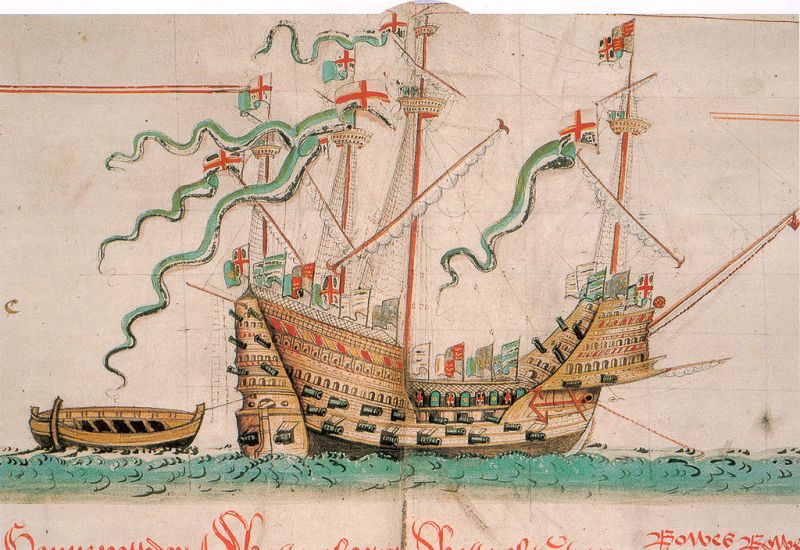
Illustration of the carrack Mary Rose. circa 1546 by Anthony Roll as reproduced in The Anthony Roll of Henry VIII's Navy: Pepys Library 2991 and British Library Additional MS 22047 With Related Document
In antiquity, field signs or standards were used in warfare that can be categorized as vexilloid or "flag-like". Examples include the Achaemenid battle standard Derafsh Kaviani, and the standards of the Roman legions such as the eagle of Augustus Caesar's Xth legion, or the dragon standard of the Sarmatians; the latter was let fly freely in the wind, carried by a horseman, but judging from depictions it was more similar to an elongated dragon kite than to a simple flag.
Right: Bronze flag, Shahdad Kerman, Iran. Date 3rd millennium BC. Source; History of Art in Iran from website: www.chap.sch.ir
During the High Middle Ages flags came to be used primarily as a heraldic device in battle, allowing more easily to identify a knight than only from the heraldic device painted on the shield. Already during the high medieval period, and increasingly during the Late Middle Ages, city states and communes such as those of the Old Swiss Confederacy also began to use flags as field signs. Regimental flags for individual units became commonplace during the Early Modern period.
During the peak of the age of sail, beginning in the early 17th century, it has been customary (and later a legal requirement) for ships to carry flags designating their nationality; these flags eventually evolved into the national flags and maritime flags of today. Flags also became the preferred means of communications at sea, resulting in various systems of flag signals. In the maritime environment semaphore is used. Semaphore is the telegraphy system conveying information at a distance by means of visual signals with hand-held flags, rods, disks, paddles, or occasionally bare or gloved hands.
A person who is interested in the study of flags is called a ‘vexillologist’; Vexillology is the "scientific study of the history, symbolism and usage of flags or, by extension, any interest in flags in general" (Smith 31) The word is a synthesis of the Latin word vexillum ("flag” or “pennant") and the Greek suffix -logia("study"). This term was conceived in 1957 by the U.S. scholar and vexillologist Whitney Smith and first appeared in print in 1959. It is formally defined by the International Federation of Vexillological Associations (known by its French acronym FIAV) constitution as "the creation and development of a body of knowledge about flags of all types, their forms and functions, and of scientific theories and principles based on that knowledge." Vexillology was originally considered a sub-discipline of heraldry and is still seen by many as such.
This week Australian National Flag Day will be celebrated on 3 September with a special guest, The Hon. Dr Brendan Nelson joining in the eclebrations to be held in Martin Place, Sydney, 12 noon. This commemorates the day in 1901 on which the Australian National Flag was first flown. On that day Australia's first Prime Minister, Edmund Barton, announced the winners of a competition to design a flag for Australia and a large flag, 5.5 metres by 11 metres, was flown over the dome of the Royal Exhibition Building in Melbourne.
On 28 August 1996, the Governor-General of Australia, Sir William Deane, issued a proclamation from Government House, Canberra that officially established 3 September as Australian National Flag Day. Australian National Flag Day is not a public holiday.
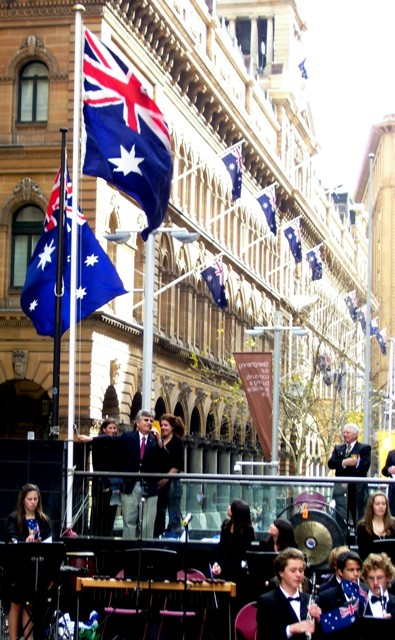 The idea of an annual day specifically celebrating the Australian National Flag dates from 1984. In that year John Christian Vaughan (pictured left), a noted vexillographer and historian, and one of our Pittwater gentlemen, arranged for the New South Wales branch of the Australian National Flag Association (ANFA) to observe 3 September as "Australian National Flag Day" at a public ceremony held in Hyde Park, Sydney. In several newspaper articles, radio and television appearances over the following years, Mr. Vaughan continued to enthusiastically advocate the observance of 3 September as Australia's National Flag Day.
The idea of an annual day specifically celebrating the Australian National Flag dates from 1984. In that year John Christian Vaughan (pictured left), a noted vexillographer and historian, and one of our Pittwater gentlemen, arranged for the New South Wales branch of the Australian National Flag Association (ANFA) to observe 3 September as "Australian National Flag Day" at a public ceremony held in Hyde Park, Sydney. In several newspaper articles, radio and television appearances over the following years, Mr. Vaughan continued to enthusiastically advocate the observance of 3 September as Australia's National Flag Day.
Mr. Vaughan encouraged all the other state branches of the ANFA to promote and organise Flag Day ceremonies for members and the general public to participate in. The recognition and popularity of Flag Day continued to grow with each passing year and in 1989 the Governor of New South Wales, David Martin, delivered a Flag Day address at Tumbalong Park, Sydney in which he said, "I come here as someone who is proudly Australian, I come here out of respect for a Flag which is proudly Australian".
On Flag Day 1996 an official ceremony took place in the Martin Place Amphitheater in the centre of Sydney. On that occasion David Jull, Minister for Administrative Services, read a message from the Prime Minister, John Howard. He then presented the ANFA with a copy of the proclamation by Sir William Deane.
Ceremonies are held annually in schools, major centres, and the Governor-General, Governors and some politicians attend or release statements to the media.
Flag of Australia
The flag of Australia is a defaced Blue Ensign: a blue field with the Union Jack in the canton (upper hoist quarter), and a large white seven-pointed star known as the Commonwealth Star in the lower hoist quarter. The fly contains a representation of the Southern Cross constellation, made up of five white stars – one small five-pointed star and four, larger, seven-pointed stars.
The flag's original design (with a six-pointed Commonwealth Star) was chosen in 1901 from entries in a worldwide competition held following Federation, and was first flown in Melbourne on 3 September 1901; this date has been proclaimed as Australian National Flag Day. A slightly different design was approved by King Edward VII in 1902. Over the next few years, the exact specifications of the flag were changed several times both intentionally and as a result of confusion. The current specifications were formally gazetted in 1934, and in 1954 the flag became recognised by, and legally defined in, the Flags Act 1953, as the "Australian National Flag".
In addition, there are other official flags representing Australia, its people and core functions of government.
History of how we were before we had a flag
Before 1901 Australia was six separate British colonies. The Union Flag, as the flag of the British Empire, was first used on Australian soil on 29 April 1770 when Lieutenant James Cook landed at Botany Bay, and it was again used at the start of European settlement of the country on 26 January 1788. after then, although each colony flew the Union Jack they also had their own flags based on the Union Flag. As an Australian national consciousness began to emerge, several flag movements were formed and unofficial new flags came into common usage.
Two attempts were made throughout the nineteenth century to design a national flag.
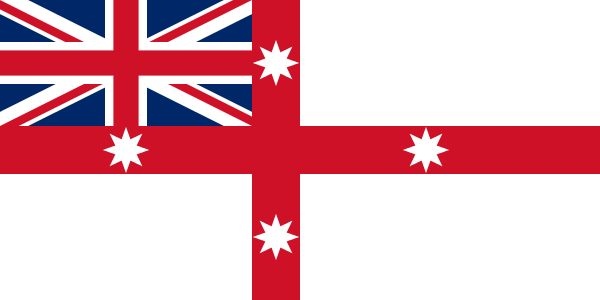 The first such attempt was the National Colonial Flag created in 1823–1824 by Captains John Nicholson and John Bingle. This flag consisted of a red cross on a white background, with an eight-point star on each of the four limbs of the cross, while incorporating a Union Flag in the canton. The most popular "national" flag of the period was the 1831 Federation Flag, also designed by Nicholson. This flag was the same at the National Colonial Flag, except that the cross was blue instead of resembling that of St. George. Although the flag was designed by Nicholson in 1831, it did not become widely popular until the latter part of the century, when calls for federation began to grow louder.
The first such attempt was the National Colonial Flag created in 1823–1824 by Captains John Nicholson and John Bingle. This flag consisted of a red cross on a white background, with an eight-point star on each of the four limbs of the cross, while incorporating a Union Flag in the canton. The most popular "national" flag of the period was the 1831 Federation Flag, also designed by Nicholson. This flag was the same at the National Colonial Flag, except that the cross was blue instead of resembling that of St. George. Although the flag was designed by Nicholson in 1831, it did not become widely popular until the latter part of the century, when calls for federation began to grow louder.
These flags, and many others such as the Eureka Flag (which came into use at the Eureka Stockade in 1854), featured stars representing the Southern Cross. The Eureka Flag is often viewed as the first "Australian" flag as it was the first notable example of a design that had the Southern Cross while excluding the Union Flag.
The oldest known flag to show the stars arranged as they are seen in the sky is the Anti-Transportation League Flag, which is similar in design to the present National Flag. The differences were that there was no Commonwealth Star, while the components of the Southern Cross are depicted with eight points and in gold. This flag was only briefly in usage, as two years after the formation of the Anti-Transportation League in 1851, the colonial authorities decided to stop the intake of convicts, so the ATL ceased its activities.
The Murray River Flag, popular since the 1850s, is still widely used by boats that traverse one of Australia's great rivers. It is the same as the National Colonial Flag, except that the white background in the three quadrants other the canton were replaced with four alternating blue and white stripes, representing the four major rivers that run into the Murray River.
.svg.jpg?timestamp=1377945162921)
Murray River Flag
As Federation approached, thoughts turned to an official federal flag. In 1900, the Melbourne Herald conducted a design competition with a prize of 25 Australian pounds (in 2009: $3,200) in which entries were required to include the Union Flag and Southern Cross, resulting in a British Ensign style flag. The competition conducted by the Review of Reviews for Australasia—a Melbourne-based publication—later that year thought such a restriction seemed unwise, despite observing that a design without these emblems were unlikely to be successful. However, it still suggested that entries incorporate the two elements in their design.
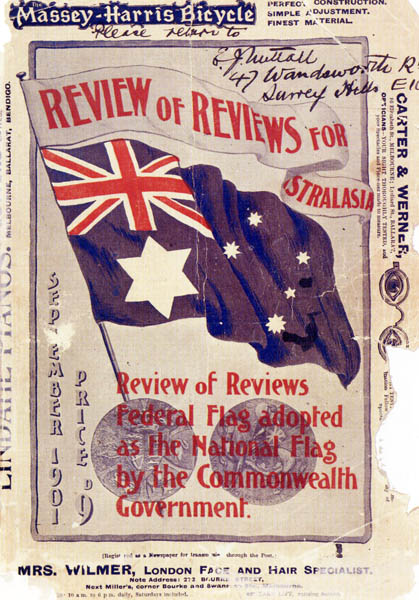 Right: The edition of the Review of Reviews front cover signed by Egbert Nuttall, after the winning designers of the 1901 Federal Flag design competition were announced, courtesy State Library of NSW.
Right: The edition of the Review of Reviews front cover signed by Egbert Nuttall, after the winning designers of the 1901 Federal Flag design competition were announced, courtesy State Library of NSW.
After Federation on 1 January 1901 and following receipt of a request from the British government to design a new flag, the new Commonwealth Government held an official competition for a new federal flag in April. The competition attracted 32,823 entries, including those originally sent to the Review of Reviews. One of these was submitted by an unnamed governor of a colony. The two contests were merged after the Review of Reviews agreed to being integrated into the government initiative. The £75 prize money of each competition were combined and augmented by a further £50 donated by Havelock Tobacco Company. Each competitor was required to submit two coloured sketches, a red ensign for the merchant service and public use, and a blue ensign for naval and official use.
The designs were judged on seven criteria: loyalty to the Empire, Federation, history, heraldry, distinctiveness, utility and cost of manufacture. The majority of designs incorporated the Union Flag and the Southern Cross, but native animals were also popular, including one that depicted a variety of indigenous animals playing cricket.
The entries were put on display at the Royal Exhibition Building in Melbourne and the judges took six days to deliberate before reaching their conclusion. Five almost identical entries were chosen as the winning design, and their designers shared the £200 (2009: $25,000) prize money.
They were Ivor Evans, a fourteen-year-old schoolboy from Melbourne; Leslie John Hawkins, a teenager apprenticed to an optician from Sydney; Egbert John Nuttall, an architect from Melbourne; Annie Dorrington, an artist from Perth; and William Stevens, a ship's officer from Auckland, New Zealand. The five winners received £40 each. The differences to the current flag were the six-pointed Commonwealth Star, while the components stars in the Southern Cross had different numbers of points, with more if the real star was brighter. This led to five stars of nine, eight, seven, six and five points respectively.
The flag's initial reception was mixed. The then republican magazine The Bulletin labelled it:
a staled réchauffé of the British flag, with no artistic virtue, no national significance... Minds move slowly: and Australia is still Britain's little boy. What more natural than that he should accept his father's cut-down garments, – lacking the power to protest, and only dimly realising his will. That bastard flag is a true symbol of the bastard state of Australian opinion.
.svg.jpg?timestamp=1377945687328)
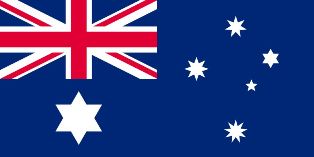
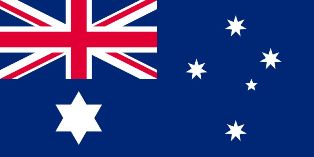
Melbourne Herald competition winning design Blue version of winning design As approved by King Edward VII
As the design was basically the Victorian flag with a star added, many critics in both the Federal Government and the New South Wales government objected to the chosen flag for being "too Victorian". They wanted the Australian Federation Flag, and Prime Minister Barton, who had been promoting the Federation Flag, submitted this flag along with that chosen by the judges to the Admiralty for final approval. The Admiralty chose the Red for private vessels and Blue Ensigns for government ships. The Barton government regarded both the Blue and Red Ensigns as colonial maritime flags and "grudgingly" agreed to fly it only on naval ships. Later governments, that of Chris Watson in 1904 and Andrew Fisher in 1910, were also unhappy with the design, wanting something "more distinctive" and more "indicative of Australian unity."
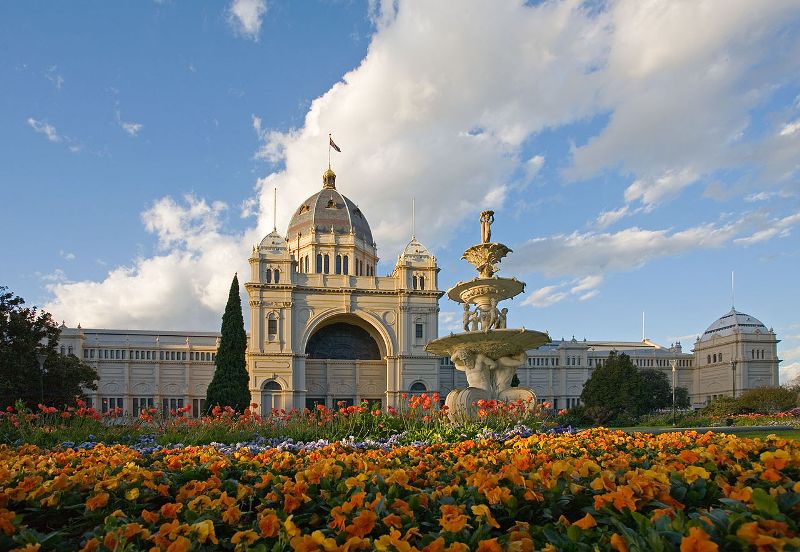
The Royal Exhibition Building, Melbourne. Site of the first flying of the Australian flag. Photo courtesy Diliff
On 3 September 1901, the new Australian flag flew for the first time from the dome of the Royal Exhibition Building in Melbourne. The names of the joint winners of the design competition were announced by Hersey, Countess of Hopetoun (the wife of the Governor-General, the 7th Earl of Hopetoun) and she unfurled the flag for the first time. Since 1996 this date has been officially known as Australian National Flag Day.
A simplified version of the competition-winning design was submitted to the British Parliament in December 1901. Prime Minister Edmund Barton announced in the Commonwealth Gazette that King Edward VII had officially recognised the design as the Flag of Australia on 11 February 1903. This version made all the stars in the Southern Cross seven-pointed apart from the smallest, and is the same as the current design except the six-pointed Commonwealth Star. This was changed to the seven pointed star in 1908.
Blue or Red Ensign?
The Red Ensign was the only flag private citizens could fly on land. By traditional British understanding, the Blue Ensign was reserved for Commonwealth Government use, with State and local governments, private organisations and individuals all using the Red Ensign. As an example, the explorer Sir Hubert Wilkins planted a red ensign in Antarctica. However, the official painting of the opening of Australia's new Parliament House in 1927 shows only Red Ensigns and Union Flags being flown. Doubt has been raised over whether Septimus Power's painting is accurate with claims the red was possibly chosen for dramatic effect or because it was the flag the Australian public was expected to use.
There was some confusion over appropriate use of the ensigns until the Flags Act 1953 set the Blue Ensign as the national flag, and the Red Ensign as the flag of the Australian mercantile marine. Red ensigns continued to be used in Anzac Day marches into the 1960s.
Technically, private non-commercial vessels were liable to a substantial fine if they did not fly the British Red Ensign. However, an Admiralty Warrant was issued on 5 December 1938, authorising these vessels to fly the Australian Red Ensign. The Shipping Registration Act 1981 reaffirmed that the Australian Red Ensign was the proper "colours" for commercial ships over 24 metres (79 ft) in tonnage length.
Replacement of the Union Jack
The blue ensign replaced the Union Jack at the Olympic Games at St Louis in 1904. In the same year, due to lobbying by Richard Crouch MP, it had the same status as the Union Flag in the UK, when the House of Representatives proclaimed that the Blue Ensign "should be flown upon all forts, vessels, saluting places and public buildings of the Commonwealth upon all occasions when flags are used". The government agreed to fly the Blue Ensign on special flag days, but not if it meant additional expense, which undermined the motion. The Blue Ensign could only be flown on a state government building if a state flag was not available.
On 2 June 1904 a resolution was passed by parliament to replace the Union Jack with the "Australian Flag" on forts. Initially the Department of Defence resisted using the Flag, considering it to be a marine ensign and favouring King's Regulations that specified the use of the Union Jack. After being approached by the Department of Defence, Prime Minister Chris Watson stated in parliament that he was not satisfied with the design of the Australian flag and that implementation of the 1904 resolution could wait until consideration was given to "adopt another [flag] which in our opinion is more appropriate."
In 1908, Australian Army Military Order, No 58/08 ordered the "Australian Ensign" replace the Union Flag at all military establishments. From 1911 it was the saluting flag of the Australian army at all reviews and ceremonial parades.
The Royal Australian Navy (RAN) was promulgated on 5 October 1911 and was directed to fly the British White Ensign on the stern and the Flag of Australia on the Jackstaff. Despite the government wanting to use the Blue Ensign on Australian warships, officers continued to fly the Union Flag, and it was not until 1913, following public protest in Fremantle after its use for the review of HMAS Melbourne, that the government "reminded" them of the 1911 legislation. The British White Ensign was finally replaced by a distinctively Australian White Ensign on 1 March 1967.
Despite the new Australian Flags official use, from 1901 until the 1920s the Federation Flag remained the most popular Australian flag for public and even some official events. It was flown at the 1907 State Premiers conference in Melbourne and during the 1927 visit to Australia of the Duke and Duchess of York, the future King George VI and Queen Elizabeth.
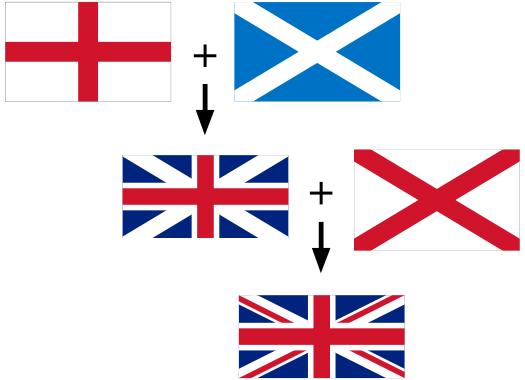 The Australian flag uses three prominent symbols: the Union Flag, the Commonwealth Star (also the Federation Star) and the Southern Cross (or Crux).
The Australian flag uses three prominent symbols: the Union Flag, the Commonwealth Star (also the Federation Star) and the Southern Cross (or Crux).
In its original usage as the flag of United Kingdom of Great Britain and Ireland, the Union Flag itself was formed from three heraldic crosses which represent the Constituent Countries of the United Kingdom (as constituted in 1801):
The red St George's Cross of England
The white diagonal St Andrew's Cross of Scotland
The red diagonal St Patrick's Cross of Ireland
The Union Flag is thought locally to symbolise Australia's history as six British colonies and the principles upon which the Australian Federation is based, although a more historic view sees its inclusion in the design as demonstrating loyalty to the British Empire.
The Commonwealth Star originally had only six points, representing the six federating colonies. However, this changed in 1908 when a seventh point was added to symbolise the Territory of Papua and any future territories. Another rationale for the change was to match the star used on the Coat of Arms, which was created in the same year. The star is also known as the Federation Star. The Commonwealth Star officially does not have any relation to Beta Centauri, despite that star's location in the sky and its brightness; however, the 1870 version of the Flag of South Australia featured the "pointer" stars, Alpha and Beta Centauri.
The Southern Cross is one of the most distinctive constellations visible in the Southern Hemisphere, and has been used to represent Australia since the early days of British settlement. Ivor Evans, one of the flag's designers, intended the Southern Cross to refer also to the four moral virtues ascribed to the four main stars by Dante: justice, prudence, temperance and fortitude. The number of points on the stars of the Southern Cross on today's Australian flag differs from the original competition-winning design, on which they ranged between five and nine points each, representing their relative brightness in the night sky. The stars are named after the first five letters of the Greek alphabet, in decreasing order of brightness in the sky. In order to simplify manufacture, the British Admiralty standardised the four larger outer stars at seven points each, leaving the smaller middle star with five points. This change was officially gazetted on 23 February 1903.
A complete specification for the current design was published in the Commonwealth Gazette in 1934.
In the 1920s there was debate over whether the Blue Ensign was reserved for Commonwealth buildings only, culminating in a 1924 agreement that the Union Flag should take precedence as the National Flag. As the Union Flag was recognised as the National flag, it was considered disloyal to fly either ensign without the Union flag alongside, and it was the Union Flag that covered the coffins of Australia's war dead.
Related Incidentals:
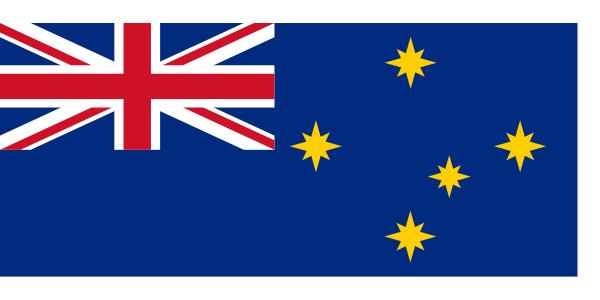 Australian Anti-Transportation League Flag
Australian Anti-Transportation League Flag
The Australian Anti-Transportation League Flag is a flag used historically by members of the Australasian Anti-Transportation League who opposed penal transportation to the British colonies which are now a part of Australia. It is particularly significant as it is the oldest known flag to feature a representation of the Southern Cross with the stars arranged as they are seen in the sky.
The flag was designed in 1849 by Reverend John West of Launceston, Tasmania, and from 1851 was used by the Australian Anti-Transportation League in the Australian colonies and in New Zealand. The flag is blue, with the Union Flag in the Canton, and the Southern Cross on the fly. Each of the stars of the Southern Cross was symbolic of a member colony. There is a white border around three sides of the flag, which was used to display the name of the League, the year it was established and the name of the colony where it was flown.
The flag was no longer used after transportation was ceased in 1853; however, the design of the flag is similar to many later flags, including the Flag of New Zealand, Flag of Victoria and Flag of Australia.
The Royal Exhibition Building and Australia’s First Parliament 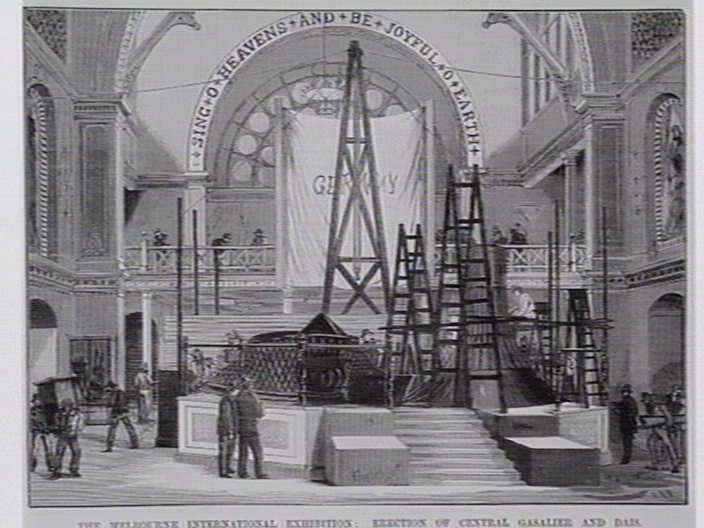 The Royal Exhibition Building is a World Heritage Site-listed building in Melbourne, Australia, completed in 1880. It is located at 9 Nicholson Street in the Carlton Gardens, flanked by Victoria, Nicholson, Carlton and Rathdowne Streets, at the north-eastern edge of the central business district. It was built to host the Melbourne International Exhibition in 1880–1881 and later hosted the opening of the first Parliament of Australia in 1901. Throughout the 20th century smaller sections and wings of the building were subject to demolition and fire; however, the main building, known as the Great Hall, survived.
The Royal Exhibition Building is a World Heritage Site-listed building in Melbourne, Australia, completed in 1880. It is located at 9 Nicholson Street in the Carlton Gardens, flanked by Victoria, Nicholson, Carlton and Rathdowne Streets, at the north-eastern edge of the central business district. It was built to host the Melbourne International Exhibition in 1880–1881 and later hosted the opening of the first Parliament of Australia in 1901. Throughout the 20th century smaller sections and wings of the building were subject to demolition and fire; however, the main building, known as the Great Hall, survived.
Right: Scene from the Melbourne International Exhibition 1880, courtesy State Library of Victoria. Date 1880
It received restoration throughout the 1990s and in 2004 became the first building in Australia to be awarded UNESCO World Heritage status, being one of the last remaining major 19th-century exhibition buildings in the world. It sits adjacent to the Melbourne Museum and is the largest item in Museum Victoria's collection. Today, the building hosts various exhibitions and other events and is closely tied with events at the Melbourne Museum.
The Royal Exhibition Building was designed by the architect Joseph Reed, who also designed the Melbourne Town Hall and the State Library of Victoria. According to Reed, the eclectic design was inspired by many sources. The dome was modeled on the Florence Cathedral, while the main pavilions were influenced by the style of Rundbogenstil and several buildings from Normandy, Caen and Paris.
The foundation stone was laid by Victorian governor George Bowen on 19 February 1879 and it was completed in 1880, ready for the Melbourne International Exhibition. The building consisted of a Great Hall of over 12,000 square metres and many temporary annexes.
1880–1901
In the 1880s, the building hosted two major International Exhibitions: The Melbourne International Exhibition in 1880 and the Melbourne Centennial Exhibition in 1888 to celebrate a century of European settlement in Australia. The most significant event to occur in the Exhibition Building was the opening of the first Parliament of Australia on 9 May 1901, following the inauguration of the Commonwealth of Australia on 1 January. After the official opening, the Federal Parliament moved to the Victorian State Parliament House, while the Victorian Parliament moved to the Exhibition Building for the next 26 years it was built it 8 years.
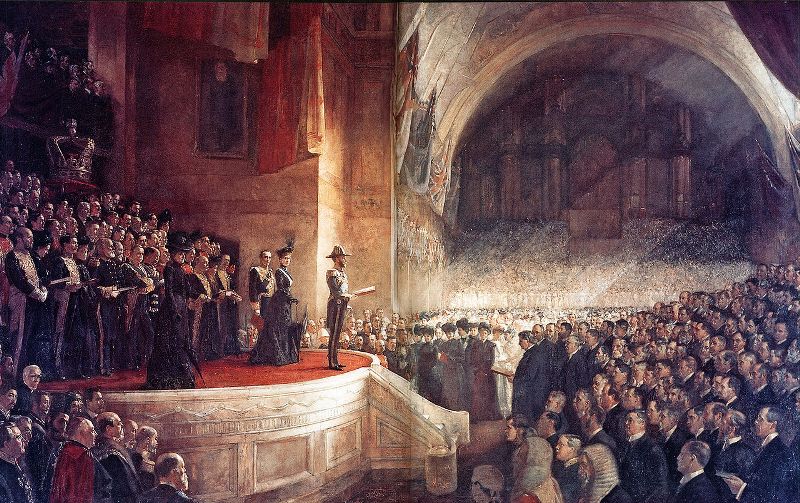
The Big Picture, the opening of the Parliament of Australia on 9 May 1901, Melbourne, Australia. Date 1903, Painted by Tom Roberts.
The Commonwealth Parliament was opened on 9 May 1901 in Melbourne, Victoria by Prince George, Duke of Cornwall and York, later King George V. The only building in Melbourne large enough to house the 14,000 guests was the Royal Exhibition Building. Thereafter, from 1901 to 1927, the Parliament met in Parliament House, Melbourne, which it borrowed from the Parliament of Victoria (which sat in the Royal Exhibition Building). On 9 May 1927 Parliament moved to the new national capital at Canberra, where it met in what is now called Old Parliament House. Intended to be temporary, this building in fact housed the Parliament for more than 60 years. The new and permanent Parliament Housewas opened on 9 May 1988 by Queen Elizabeth II.
On 3 September 1901, the Countess of Hopetoun, wife of the Governor-General, announced the winners of a competition to design the Australian National Flag. A large flag, 5.5 metres by 11 metres, was unfurled and flown over the dome of the Royal Exhibition Building
Construction sheet for the Flag of Australia. The length of the Flag is twice the width.
Under the Flags Act, the Australian National Flag must meet the following specifications:
the Union Flag occupying the upper quarter next the staff;
a large seven-pointed white star (six representing the six states of Australia and one representing the territories) in the centre of the lower quarter next the pye and pointing direct to the centre of St George's Cross in the Union Flag;
5 white stars (representing the Southern Cross) in the half of the flag further from the staff.
The location of the stars is as follows:
Commonwealth Star – 7 pointed star, centred in lower hoist.
Alpha Crucis – 7 pointed star, straight below centre fly 1/6 up from bottom edge.
Beta Crucis – 7 pointed star, 1/4 of the way left and 1/16 up from the centre fly.
Gamma Crucis – 7 pointed star, straight above centre fly 1/6 down from top edge.
Delta Crucis – 7 pointed star, 2/9 of the way right and 31/240 up from the centre fly.
Epsilon Crucis – 5 pointed star, 1/10 of the way right and 1/24 down from the centre fly.
The outer diameter of the Commonwealth Star is 3/10 of the flag's width, while that of the stars in the Southern Cross is 1/7 of the flag's width, except for Epsilon, for which the fraction is 1/12. Each star's inner diameter is 4/9 of the outer diameter. The flag's width is the measurement of the hoist edge of the flag (the distance from top to bottom).
References
Australian National Flag website: http://www.australianflag.org.au/
Flag of Australia. (2013, July 18). In Wikipedia, The Free Encyclopedia. Retrieved from http://en.wikipedia.org/w/index.php?title=Flag_of_Australia&oldid=564736667
Australasian Anti-Transportation League Flag. (2013, March 15). In Wikipedia, The Free Encyclopedia. Retrieved fromhttp://en.wikipedia.org/w/index.php?title=Australasian_Anti-Transportation_League_Flag&oldid=544263064
Royal Exhibition Building. (2013, August 7). In Wikipedia, The Free Encyclopedia. Retrieved from http://en.wikipedia.org/w/index.phptitle=Royal_Exhibition_Building&oldid=567503274
Vexillology. (2013, August 9). In Wikipedia, The Free Encyclopedia. Retrieved from http://en.wikipedia.org/w/index.php?title=Vexillology&oldid=567875564
Flag. (2013, August 16). In Wikipedia, The Free Encyclopedia. Retrieved from http://en.wikipedia.org/w/index.php?title=Flag&oldid=568799969
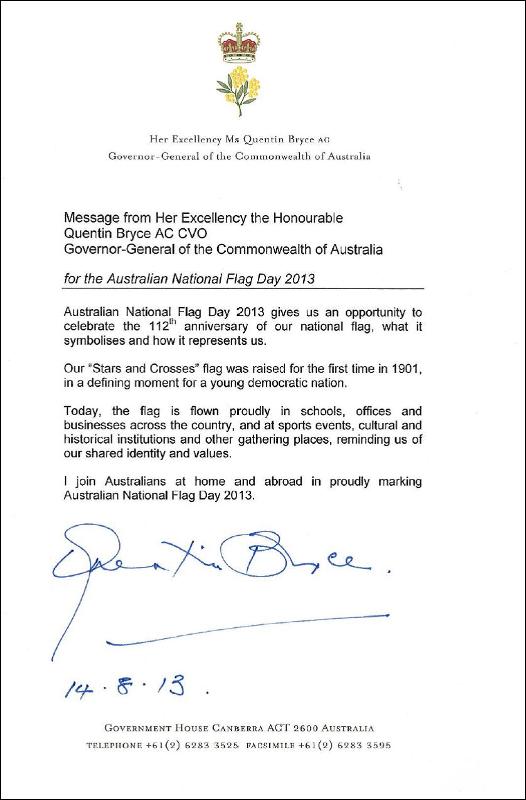
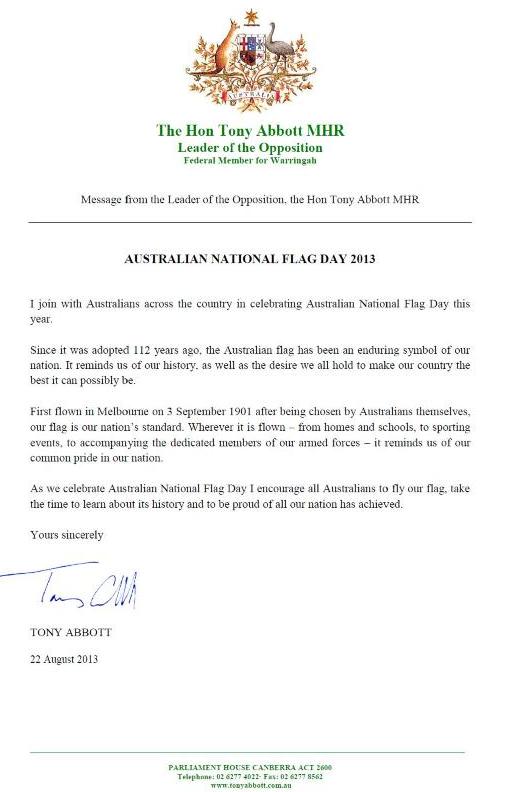
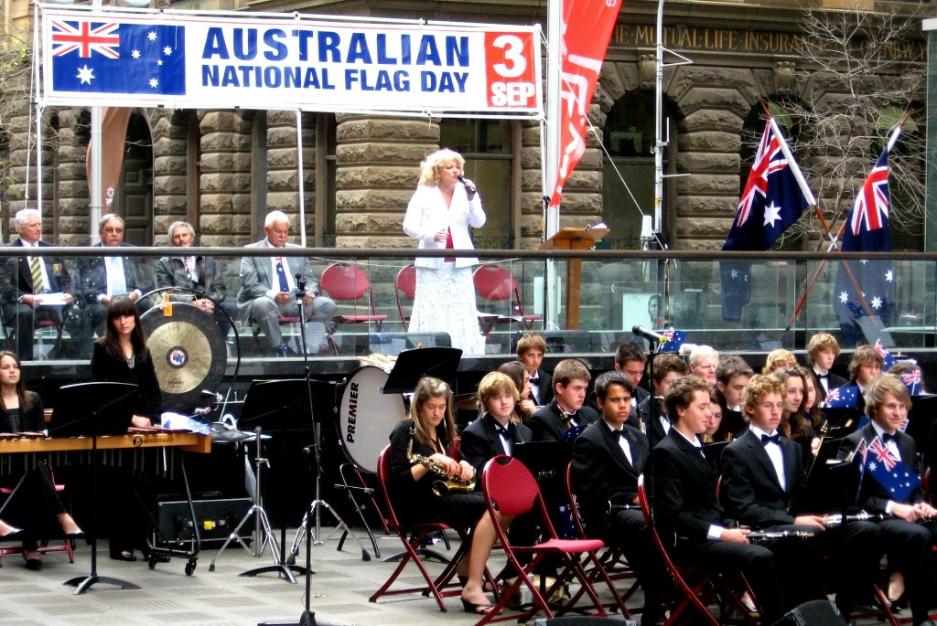
Australian Flag Day 2007, Miss Diana Hammond - entertainer. Photo Courtesy John Vaughan.